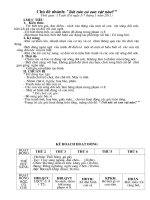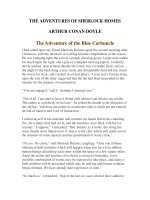3 7 1 do i really need it
Bạn đang xem bản rút gọn của tài liệu. Xem và tải ngay bản đầy đủ của tài liệu tại đây (3.52 MB, 10 trang )
Fascinating Facts
• People are learning that they must be smarter
about money. Because of this, books about
saving money and making good economic
choices are now bestsellers.
Do I Really
NEED It?
• Children as young as three years of age
recognize brand names and images.
• The United States has more opportunities to
earn, save, and spend than any other country.
Genre
Nonfiction
Comprehension Skill
Sequence
Text Features
• Glossary
• Chart
Scott Foresman Social Studies
ì<(sk$m)=beidej< +^-Ä-U-Ä-U
ISBN 0-328-14834-2
by Maureen Blaney Flietner
In this book, you will read about the
world of money. You will read about
how money is a part of all our lives.
Vocabulary
savings
budget
Do I Really
NEED It?
Write to It!
When we earn money and make a
budget, we can buy what we need
and what we want. We also can save
money to pay for our needs and wants
in the future. Write two sentences about
something that you might want to save up
to buy.
nonrenewable resources
renewable resources
supply
Write your sentences on a separate sheet
of paper.
demand
Photographs Every effort has been made to secure permission and provide appropriate credit for photographic material.
The publisher deeply regrets any omission and pledges to correct errors called to its attention in subsequent editions.
Unless otherwise acknowledged, all photographs are the property of Scott Foresman, a division of Pearson Education.
Photo locators denoted as follows: Top (T), Center (C), Bottom (B), Left (L), Right (R), Background (Bkgd).
by Maureen Blaney Flietner
ISBN: 0-328-14834-2
Copyright © Pearson Education, Inc. All Rights Reserved. Printed in the
United States of America. This publication or parts thereof, may be used with appropriate
equipment to reproduce copies for classroom use only.
1 2 3 4 5 6 7 8 9 10 V0G1 14 13 12 11 10 09 08 07 06 05
Opener: Getty Images
2 ©Myrleen Ferguson Cate/PhotoEdit
3 ©Scott Barbour/Getty Images
4 Paul Redman/Getty Images
5 ©Darama/Corbis
6 Getty Images
8 ©Craig Aurness/Corbis
10 ©Joel Stettenheim/Corbis
Editorial Offices: Glenview, Illinois • Parsippany, New Jersey • New York, New York
11 ©Grishkin Denis/ITAR-TASS/Corbis
12 ©James L. Amos/Corbis
Sales Offices: Needham, Massachusetts • Duluth, Georgia • Glenview, Illinois
13 ©Spencer Grant/PhotoEdit
Coppell, Texas • Sacramento, California • Mesa, Arizona
14 Getty Images
15 Tom Stewart/Corbis
It Is Your Money
Nickels. Dimes. Quarters. Dollars. You
may have some money saved up. How
did you get it?
Did you earn your money? Money
can be earned when you work at a job.
Maybe you fed the cat.
What do you do with your money? Are
you spending? When you spend money,
you use it to buy something.
Maybe you put your money into
savings. When you save, you keep your
money to use later.
2
3
What Do You Really Need?
A need is something you must have.
Food, clothing, and a place to live are
needs. The things we need cost money.
You may think you need something. Then
you must decide if you can live without it.
So Many Things to Want!
A want is something you would like to
have, but that you can live without. You
may want a new music CD and fancy
shoes, but they are not needs.
What is something you want? Why
do you want it? Businesses want you to
buy the things they sell so they can earn
money. You must decide if what they want
you to buy is something you really need.
4
5
Plan Ahead
Do you think about what you are going
to do this weekend? You are planning
ahead.
Think about the future and your money.
If you saved your money for three months,
how much would you have? What would
you do with it? You should have a goal for
your money.
Make a Plan for Your Money
You can reach your goal by making a
budget. A budget is a plan for how to
spend and save your income.
6
Make a budget for a bicycle that will
cost $100. Suppose your allowance and
job money add up to $10 a week. If
you save all of it, you could save enough
money to buy the bicycle in 10 weeks. If
you save only $5 each week and spend
$5 each week, it would take 20 weeks to
get your bike.
Saving for a Bicycle
Week 1
$10
Week 2
$10
Week 3
$10
Week 4
$10
Week 5
$10
Week 6
$10
Week 7
$10
Week 8
$10
Week 9
$10
Week 10
$10
Total
$100
7
Budgets Work for Families
Budgets are good for families. If your
family has a budget, it will be a plan that
shows how your family will pay for its
needs and wants. A family should pay for
all of its needs first and then for its wants.
Saving Helps Everybody
Families can save money in many
ways. Turn off the lights when you are not
using them. Your family may pay less for
electricity. The world may use less coal
and gas to make more electricity.
Coal and gas are nonrenewable
resources. That means these resources
cannot be made again. Wind and water
are renewable resources. They can be
made again.
8
9
Many Toys and No Toys
You Choose
Suppose you would like a music CD or
a video game. You decide you want the
music CD. When you choose one item
instead of another, you are making a
choice.
Remember our sample budget? If you
buy the music CD, it will change your
budget because you will be spending and
not saving. It will take you longer to save
for the bicycle.
10
Sometimes when a new toy comes out
everybody wants it. At first the supply
is big. Because the new toy is something
many children want, there is a big
demand for it. If the demand is bigger
than the supply, the supply may run out.
Then there are no more toys left to buy.
Months later, you find that the toy is in
the store again. This time there is not much
demand so it is on sale.
11
Learn Before You Spend
You want to learn about bicycles before
you spend your money. You can read
about bicycles at the library. You can visit
stores to see bicycles and their prices.
You finally decide on a company that
has the bicycle you want. The company
has buildings, tools, and workers to make
the bicycles.
You Made a Budget and
Reached Your Goal!
The big day is here! You saved $100 for
your bicycle.
Your $100 goes to the owner of the
bicycle store. The owner pays the people
who work at the store. The owner pays the
people who make the bicycles. The owner
pays a tax, or money for the government.
Finally, the owner keeps the profit, or the
money left over.
12
13
Money Moves
Through Many Hands
The money you earned and spent on
the bicycle has now gone to other people.
People earn money by providing goods
or services. Those people take that money
and spend it or save it for things that they
need or want.
Make Smart Choices
In our sample budget, you saved for
a bicycle. You made choices about how
much to save and how much to spend.
Now you can make a real budget. If
you are smart with your money and learn
more about it, you will have enough
money for your needs and your wants.
14
15
Glossary
In this book,
aboutsavings,
the
budget
a planyou
forwill
yourread
income,
world of money. You will read about
and spending
how money is a part of all our lives.
demand the number of goods or
services that people want and will buy
Vocabulary
at a given price
savings
nonrenewable budget
resources supplies
that cannot be made again
nonrenewable resources
renewable
resources
supplies that can
renewable
resources
be created naturally
supply
savings money demand
you have kept for
future use
Write to It!
When we earn money and make a
budget, we can buy what we need
and what we want. We also can save
money to pay for our needs and wants
in the future. Write two sentences about
something that you might want to save up
to buy.
Write your sentences on a separate sheet
of paper.
supply the number of goods or services
that producers are willing to make at a
given price
Photographs Every effort has been made to secure permission and provide appropriate credit for photographic material.
The publisher deeply regrets any omission and pledges to correct errors called to its attention in subsequent editions.
Unless otherwise acknowledged, all photographs are the property of Scott Foresman, a division of Pearson Education.
Photo locators denoted as follows: Top (T), Center (C), Bottom (B), Left (L), Right (R), Background (Bkgd).
ISBN: 0-328-14834-2
Copyright © Pearson Education, Inc. All Rights Reserved. Printed in the
United States of America. This publication or parts thereof, may be used with appropriate
equipment to reproduce copies for classroom use only.
1 2 3 4 5 6 7 8 9 10 V0G1 14 13 12 11 10 09 08 07 06 05
16
Opener: Getty Images
2 ©Myrleen Ferguson Cate/PhotoEdit
3 ©Scott Barbour/Getty Images
4 Paul Redman/Getty Images
5 ©Darama/Corbis
6 Getty Images
8 ©Craig Aurness/Corbis
10 ©Joel Stettenheim/Corbis
11 ©Grishkin Denis/ITAR-TASS/Corbis
12 ©James L. Amos/Corbis
13 ©Spencer Grant/PhotoEdit
14 Getty Images
15 Tom Stewart/Corbis









